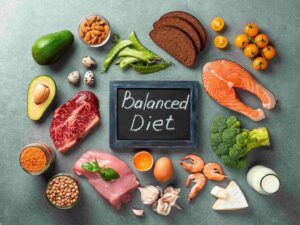Table of Contents
When discussing healthy eating, the advice to “eat plenty of fruits and vegetables” is a common phrase, but what exactly does it mean? While these two food groups are often linked together, their differences in nutritional value and recommended intake raise some important questions about how to balance them in your diet.
What’s the Difference Between Fruits and Vegetables?
While many people differentiate between fruits and vegetables based on taste—fruits being sweet and vegetables being savory—this classification is not entirely accurate. The primary difference lies in the part of the plant each comes from. Fruits develop from the flower of a plant and contain seeds, while vegetables are derived from other parts like stems, leaves, and roots.
For instance, cucumbers, pumpkins, and avocados are technically fruits, but they are often mistaken for vegetables due to their culinary use. Understanding these distinctions can help guide healthier choices when planning meals, as both food categories offer unique benefits to your diet.
Understanding the Proper Ratio: How Much of Each Should You Eat?
Most dietary guidelines suggest that fruits and vegetables should make up half of your plate at every meal. But how should this be divided? Experts typically recommend consuming slightly more vegetables than fruits, as vegetables tend to be lower in sugar and calories. A common ratio suggested is two servings of fruit and three servings of vegetables per day.
This balance ensures you’re getting a variety of nutrients without overloading on natural sugars found in fruit, which can lead to an unintentional calorie surplus.
Why Vegetables Are Often More Difficult to Eat Than Fruits
Fruits are naturally sweet and enjoyable to eat, which explains why people often have no trouble including them in their diets. In contrast, vegetables can be less palatable for some individuals, which makes it more challenging to meet daily recommendations. To overcome this, it’s helpful to keep your meals visually colorful by including a range of fruits and vegetables.
If fresh vegetables are hard to come by, frozen options are a great alternative. Keeping a stock of frozen veggies allows you to quickly add them to your meals, ensuring that your diet remains nutritious even on busy days.

The Balance Between Fruits and Vegetables in Your Diet
Fruits Often Mistaken as Vegetables
Several fruits are commonly mistaken for vegetables, including:
- Tomatoes
- Avocados
- Peppers
- Eggplants
- Zucchini
On the other hand, vegetables like sweet potatoes and beets, due to their naturally sweet taste, are sometimes confused as fruits. However, they remain vegetables based on their botanical classification.
The Nutritional Value of Fruits and Vegetables
Why You Should “Eat the Rainbow”
The concept of “eating the rainbow” refers to the importance of including a variety of colored fruits and vegetables in your diet. Each color group provides distinct nutrients, all of which contribute to better health.
For example, orange and yellow fruits such as carrots and pumpkins are high in beta-carotene, which supports eye health, while leafy greens are rich in lutein, beneficial for brain health. Berries, with their anti-inflammatory anthocyanins, promote heart health and reduce the risk of chronic diseases.
Nutrition Comparison: Fruit vs. Vegetables
Fruits tend to be higher in natural sugars and calories, making them a quick source of energy. Vegetables, on the other hand, are generally lower in calories and richer in essential nutrients like fiber, vitamins, and minerals. This is why it’s often recommended to consume more vegetables than fruits to maintain a balanced diet.
Both groups are naturally low in sodium, high in water content, and rich in phytochemicals—bioactive compounds that provide antioxidant properties.
Health Benefits of Including Fruits and Vegetables in Your Diet
1. Disease Prevention
Numerous studies show that consuming a variety of fruits and vegetables is key to preventing chronic diseases such as cardiovascular issues, cancer, and osteoporosis. According to research published by the American Heart Association, people who consume higher amounts of leafy greens, cruciferous vegetables, and citrus fruits experience a reduced risk of these conditions.
2. Weight Management
Since fruits and vegetables are low in calories but high in fiber, they help you feel full longer, aiding in weight management. A study published in the American Journal of Clinical Nutrition highlighted that people who eat more fruits and vegetables tend to have healthier body mass indexes, even when they are genetically predisposed to weight gain.
3. Rich in Fiber
Both fruits and vegetables are rich in soluble fiber, which supports digestion and promotes gut health. The fermentation of fiber by gut bacteria is linked to improved immune function, and fiber’s role in reducing cholesterol levels can help prevent heart disease.
4. Antioxidant Benefits
The high levels of antioxidants in fruits and vegetables play a crucial role in combating oxidative stress in the body, which is associated with aging and chronic disease. Antioxidants such as beta-carotene, lutein, and anthocyanins help protect the body from cellular damage, promoting overall longevity.
Potential Risks and Side Effects
For most people, there are no significant risks to consuming fruits and vegetables unless they have food allergies. However, it’s essential to be mindful of fruit intake, as overeating fruit can result in excess sugar and calorie consumption.
As a general rule, two to three servings of fruit per day is beneficial, but overdoing it can lead to weight gain if not balanced with sufficient vegetable intake.
Conclusion
Incorporating a mix of fruits and vegetables into your diet is vital for maintaining overall health. Not only do they provide essential vitamins, minerals, fiber, and antioxidants, but they also help prevent chronic diseases, support weight management, and promote healthy aging.
While fruits are sweet and delicious, they contain higher sugar content, so focusing slightly more on vegetable consumption is often a better strategy for long-term health. By following the guidelines of including two to three servings of each food group per day and “eating the rainbow,” you can enjoy the diverse benefits that fruits and vegetables have to offer.